Plastic pollution has become a ubiquitous problem and posing a significant threat to our ecosystems. From the depths of the oceans to the highest peaks of the mountains, plastic waste is everywhere in our blue planet.
It is estimated that 1.5–4% of global plastics production ends up in the oceans every year because of various reason such as littering, excessive use of single use plastics, poor waste management infrastructure, packaging and industrial revolution, fishing and aqua cultural activity.
By 2050, it is suggested by some researchers that the weight of plastic in the oceans may exceed that of fish.
Currently, plastic manufacturing and its use at its highest peak, but the recycling rate for plastics are only 10%, which are very low. So as a result, rest of plastics either gets incinerated or finds its way into the environment.
Table of Contents
Introduction
What is plastic pollution?
Plastic pollution refers to the accumulation of plastic products, particles and debris in the environment, particularly in oceans, rivers, lakes and on land that affects ecosystems, wildlife, human health and the economy.
Plastics are human made synthetic polymer that was invented one century ago, but its use exist after 1950. It is made from various organic compounds, primarily from fossil fuels like crude oil and natural gas.
Natural polymer such as rubber and silk are also exist in abundance, but they can easily degrade without showing any environmental impact. While in case of synthetic polymer like plastic, 500-1000 years require to degrade. Even after those years plastics do not breakdown, they simply break up called microplastics.
In ocean, sunlight, saline water and mechanical forces can cause plastic into smaller pieces known as microplastics, but these smaller pieces do not truly biodegrade.
According to the Environmental Protection Agency (EPA), all plastics whichever produced by humans till now persist in the environment due to its non-biodegradable nature.
Plastics are durable, lightweight, versatile and inexpensive, which are the reason for their widespread use in numerous applications, including packaging, construction, textiles, electronics and transportation.
Plastic has slow recovery rate as compare to other material like glass, paper and metal. So rather than recycling, manufacturer uses virgin polymer for plastic product manufacturing. These all plastics waste find their way into lands or oceans.
Recycling is crucial, but will not be the solution to plastic pollution.
The majority of recycled plastics undergo downcycling, wherein they are transformed into products of reduced quality that are less probable to undergo subsequent recycling processes.
Initially, all plastics may linger in coastal waters, but soon it can be caught by circulating ocean currents known as gyres and transported to anywhere in the world.
What is the great Pacific garbage patch?
The Great Pacific Garbage Patch is a vast area in the North Pacific Ocean that accumulates a significant amount of plastic debris. It is not a solid mass of garbage but rather a region where marine litter, mostly plastics, is concentrated due to ocean currents and winds.
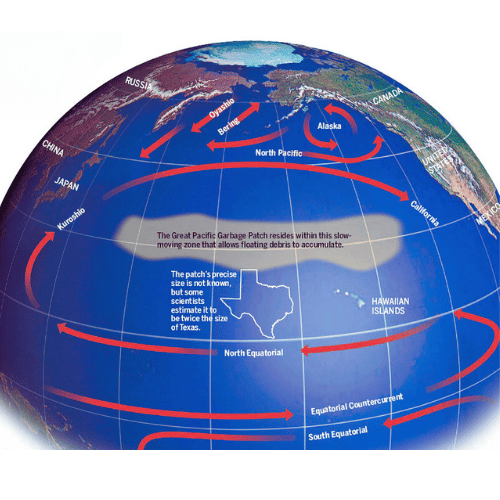
How is a garbage patch created?
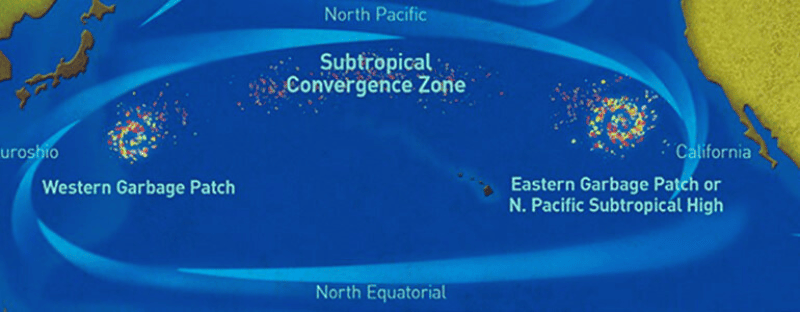
A gyre is a circular ocean current, which is formed by Earth’s wind patterns and the rotational forces of the planet.
The area in the center of a gyre remains very calm and stable. Its circular movement attracts microplastics and accumulate in the center of gyre and creating a garbage patch.
Microplastics accumulates in the center of gyres are known as garbage patches. For example, the Great Pacific Garbage Patch exists in the North Pacific between the California and Hawai’i.
What are the types of plastic pollution?

Macroplastics
Macroplastics are large plastic items and debris (>5 mm) that are visible to the naked eye. These can be plastic bottles, bags, containers, packaging and fishing nets.
Macroplastics can accumulate in water bodies, shorelines and terrestrial environments, which are posing hazards to aquatic life, wildlife and human health.
Microplastics
Microplastics are tiny plastic particles (<5 mm). They can result from the breakdown of larger plastic items or from the intentional manufacturing of certain applications, such as microbeads or scrubs in personal care products.
Nanoplastics
Nanoplastics are even smaller plastic particles (<100nm). They can originate from the breakdown of larger plastic items, degradation of microplastics or be intentionally produced at the nanoscale for various applications.
Because of their smaller size, Nanoplastics can potentially harm at cellular and molecular levels.
What are the sources of plastic pollution?
Plastic pollution originates from various sources, including:
Single-Use Plastics
These plastics are designed for single use and then for disposal. Single use plastics are not intended for long-term use or recycling, which are contributing significant plastic pollution.
Examples: Plastic bottles, bags, straws, wrappers, cutlery, and takeout containers.
Packaging
Packaging constitutes a substantial portion of plastic waste on a global scale. Plastic packaging is used extensively in industries such as food and beverage, pharmaceuticals, healthcare sectors, cosmetics, electronics, consumer goods, and many more.
Excessive packaging, including plastic wrappers, trays, and blister packs, generates substantial plastic waste, much of which ends up in landfills or waters.
Littering
Improper disposal and littering are major contributors to plastic pollution.
Despite efforts to raise awareness about proper waste disposal, littering remains a significant source of plastic pollution.
Plastic items discarded in streets, parks, and water bodies eventually find their way into the environment.
Industrial Processes
Plastic pollution can result from various industrial processes, including manufacturing, packaging, and transportation.
Plastic pellets (nurdles), used as raw materials in plastic production, can be accidentally spilled or released during handling and transportation, leading to contamination of waterways and marine environments.
Microplastics from Synthetic Textiles
Synthetic textiles such as polyester, nylon and acrylic release microplastic fibers during washing, wearing and disposal.
Plastic products do not biodegrade; instead, they break up into smaller fragments over time due to exposure of sunlight, water and physical wear. These smaller particles, known as microplastics, can be as tiny as a grain of sand or even smaller.
Fishing and Aquaculture
The fishing and aquaculture industries create plastic pollution through lost or discarded fishing gear, such as nets, lines and traps.
Fishing gear left behind or misplaced, commonly known as “ghost gear”. This ghost gear is too heavy in weight (up to 6 tonnes) and continues to trap and entangle marine animals, such as turtle, whale, seal etc.
Environmental Impacts of Plastic Pollution
Marine Ecosystems
The ocean is the ultimate destination for the plastic waste produced on land due to its downstream position. 7-8 million tons of plastic enters into the ocean every year, in which China, Philippines and Indonesia are at the top.
It is estimated that each day oceans receive the volume of plastic waste that could fill 2,000 garbage trucks.
As these plastics breaking down by photodegradation, they releases plastic additives or chemicals, such as bisphenol A (BPA), phthalates and polybrominated diphenyl ether (PBDE), which can contribute serious environmental and health problems.
Moreover, microplastics can also absorb pollutants, such as PCBs from the ocean and eventually enter into the food chain when consumed by marine life.
Impacts on Marine Life
Plastic pollution poses direct threats to marine life through ingestion, entanglement and habitat degradation.
Marine animals, including seabirds, turtles, seal, fish and marine mammals can mistake plastic debris as a food and ingest them. Later on, this can cause potential digestive blockages, internal injuries, malnutrition, difficulty in swimming and starvation.
Turtles often mistake plastic bags for their favorite food (jellies).
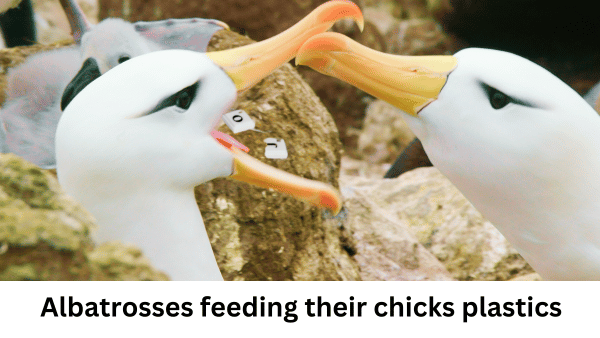
Albatrosses frequently mistake plastic pellets for fish eggs and accidentally feed them to their chicks, resulting in the death of the young birds.
Seabirds requires enough nutrients to fuel their migration and reproduction processes. However, the ingestion of marine plastic debris is hamper their ability to accumulate sufficient amount of fat for migration and reproduction.
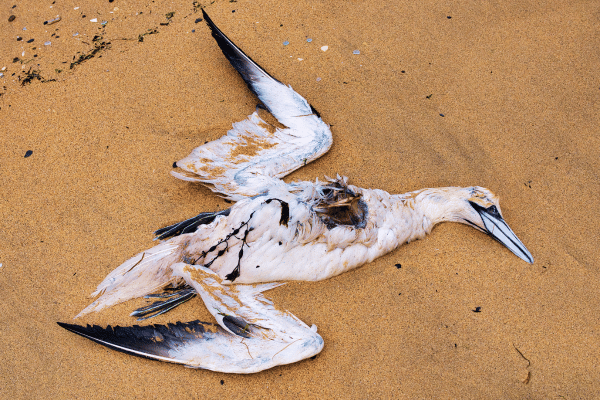
With inadequate nutrition, seabirds may not be able to migrate. They may die because of harsh weather condition or need to make frequent stops for nourishment along the way.
Migration time is very crucial and reaching late at breeding sites may provide depleted food resources and nesting sites, which can affect their survival.
Additionally, larger marine animals like whales and dolphins can become entangled or trapped in fishing gear and other plastic debris, resulting in injuries, suffocation, drowning and eventually death.
Disruption of Marine Food Chains
Microplastics are become more accessible to wider range of marine organisms, thereby spreading ingestion and toxicity through the food chain.
Ingestion and Toxicity
Plastics can leach harmful chemicals such as bisphenol A (BPA), phthalates and polychlorinated biphenyls (PCBs) into the marine environment. Plants can also absorb these chemicals through water.
These chemicals can accumulate in the tissues of marine animals when they ingest plants or plastics.
Bioaccumulation
Bioaccumulation of microplastics refers to the gradual buildup of these tiny plastic particles in the tissues of living organisms over time.
Through a process of bioaccumulation, plastic-associated toxins can become more concentrated as they move up into the food chain.
For example, tiny marine organisms ingest microplastics, which are subsequently consumed by larger predators in the marine ecosystem.
As larger predators consume more tiny marine organisms, they accumulate higher concentrations of plastic-associated toxins in their tissues, which can have detrimental effects on their health and reproductive success.
Coral Reefs

Coral reefs is the most biodiverse and economically valuable marine ecosystems.
Plastic debris can choke and damage coral reefs, blocking sunlight and inhibiting coral growth and reproduction.
Plastic pollution can also introduce chemical pollutants and pathogens into coral reef, which can contribute coral bleaching, disease outbreaks and ecosystem degradation.
Furthermore, plastic debris can entangle and injure reef organisms, disrupt critical ecological processes and degrade the overall health and resilience of coral reef ecosystems.
Terrestrial Ecosystems
Plastic pollution not only affects marine ecosystems, but also has significant impacts on terrestrial ecosystems, including soil contamination and wildlife.
Rising levels of plastic and microplastic pollution in soil can lead to detrimental effects on both plants and soil microorganisms, subsequently affecting soil fertility.
It diminishes seedling germination and changes plant characteristics such as leaf count, stem diameter and chlorophyll levels.
Soil Contamination

By the year 2050, it is projected that landfills will contain around 12 billion metric tons of plastic.
Plastic pollution can contaminate soil in surrounding environments through the deposition of plastic debris.
Plastic waste accumulates more in soil over time due to its non-biodegradable nature. Plastic debris can alter soil structure, reduce soil fertility and hamper water infiltration (downward entry of water into soil).
Contaminated soil can affect plant growth, productivity, and disrupt eco-friendly organisms and microbes.
Wildlife Impact
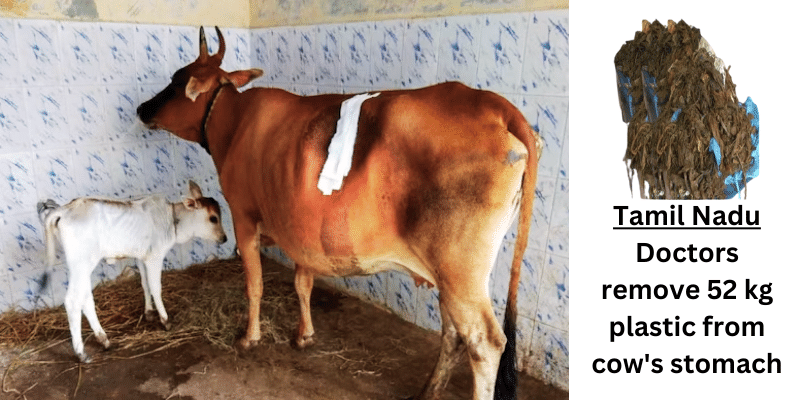
Plastic pollution in terrestrial ecosystems can have adverse effects on wildlife populations and biodiversity.
Plastic ingestion can cause digestive blockages, internal injuries and malnutrition in wildlife species, impacting their survival, reproductive success and their population.
The ingestion of plastic by animals not only results in death due to intestinal blockage but also poses greater risks as it moves up into the food chain, ultimately affecting humans.
Many chemicals used in plastic manufacturing are recognized as carcinogenic and capable of disrupting the body’s endocrine system. These disruptions can lead to developmental, reproductive, neurological and immune disorders in both humans and wildlife.
Impacts on Human Health
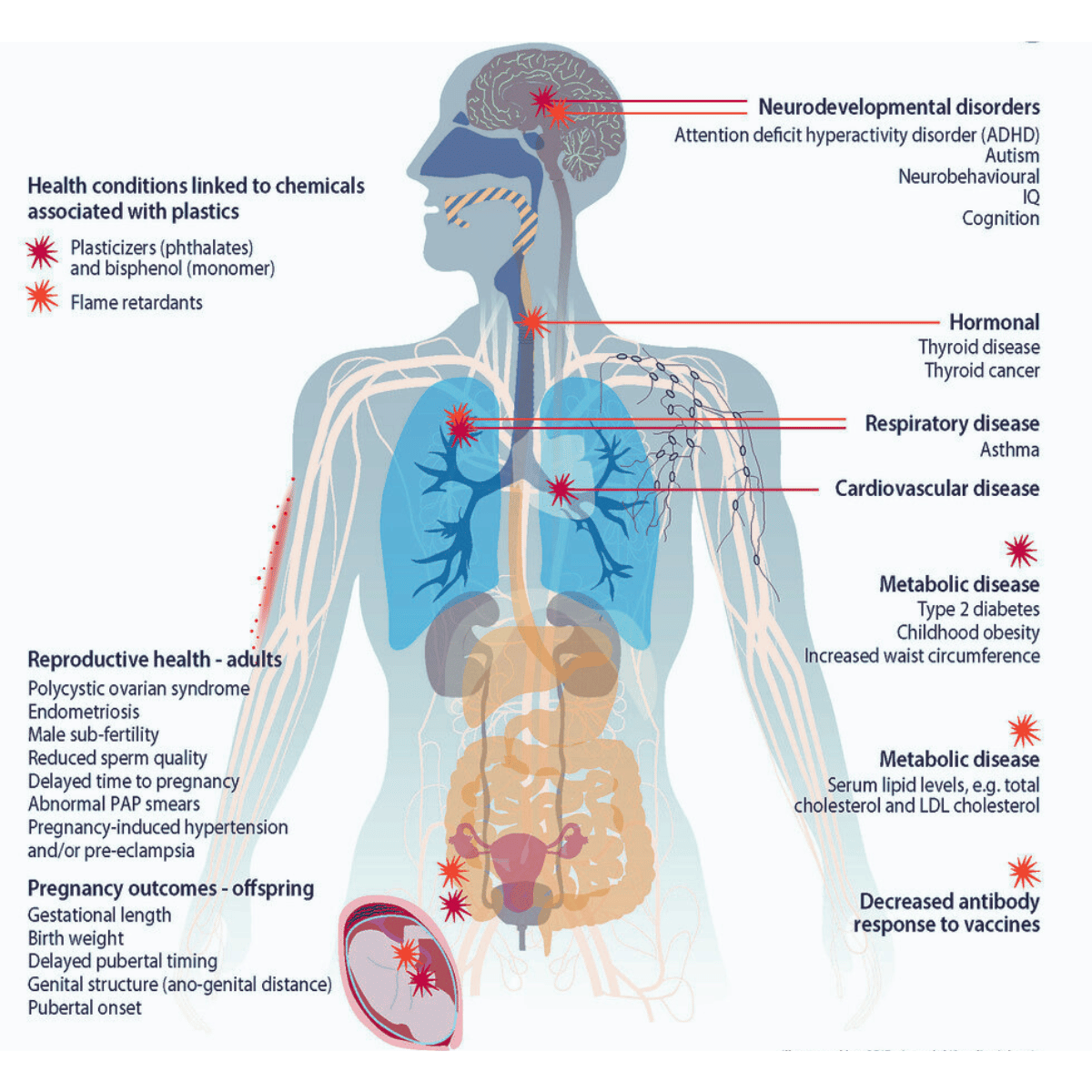
When marine organisms ingest microplastics, these tiny particles can comes into the food chain, ultimately making their way into humans through the consumption of marine organism or seafood.
The health impacts of ingesting microplastics are still being studied, but concerns include potential toxicity and the accumulation of harmful chemicals.
Some of the key impacts of plastic pollution on human health.
Ingestion of Microplastics
Microplastics have been found in sea creatures ranging from tiny plankton to massive whales as well as in seafood that people eat and even in the water we drink.
Unfortunately, traditional water treatment plants are unable to eliminate all microplastics.
Additionally, microplastics can absorb other dangerous chemicals before marine creatures consume them.
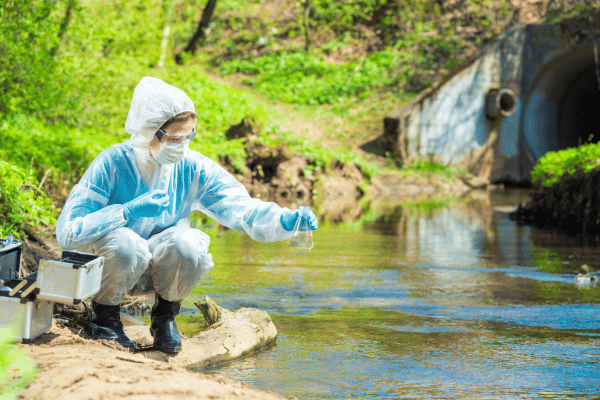
Reports indicate that the average person may ingest up to 5 grams of plastic per week.
Ingested microplastics can accumulate in the gastrointestinal tract and potentially transfer harmful chemicals and pollutants to human tissues and raising health issues, such as inflammation, oxidative stress and the disruption of endocrine and immune functions.
Absorption of Chemicals
Microplastics have the ability to adsorb chemical pollutants and additives from the surrounding environment, which can accumulate in human tissues and contribute to toxicological risks, including neurological and developmental disorders, immune dysfunction and carcinogenicity.
Some additives found in plastics, like phthalates, bisphenol A (BPA), and polybrominated diphenyl ether (PBDE), are currently under scrutiny and subject to regulation.
Phthalates
Phthalates are plasticizers, which are used in plastic products to make them less brittle.
Example: Medical devices, food packaging, automobile upholstery, flooring materials, computers, pharmaceuticals, perfumes and cosmetics products.
Phthalates are recognized as anti-androgens for their ability to counteract male hormones.
Bisphenol A (BPA)
Bisphenol A (BPA) used in the manufacture of hard polycarbonate plastics, strong epoxy coatings, adhesives, bottles, compact discs, medical devices and the linings of food cans.
BPA mimics the natural female hormone estrogen.
Polybrominated diphenyl ether (PBDE)
PBDE is added into plastics as a flame retardant. All of these compounds have been identified in humans and are recognized for their capacity to disrupt the endocrine system.
PBDE has been shown to disrupt thyroid hormones also.
Children and women in their reproductive years are most susceptible with PBDE.
Plastic contains variety of additives and chemicals, including plasticizers, flame-retardants and stabilizers, which can leach out from plastic and contaminate food and water, which may subsequently cause thyroid dysfunction, obesity, diabetes, reproductive impairment and other health related issues.
Additionally, these particles can absorb persistent organic pollutants (POPs), heavy metals and other toxic substances, which may leach out into tissues and fluids upon ingestion.
Translocation across Biological Barriers
Microplastics or nanoplastics have been shown to translocate across biological barriers, including the gut epithelium, blood-brain barrier and placental barrier.
These particles may enter systemic circulation and distribute throughout the body, potentially reaching organs and tissues, causing neurotoxicity, immunotoxicity and reproductive toxicity.
Inhalation
Microplastics can also be inhaled and have been detected in human organs, including in the placentas of unborn babies.
Inhalation of airborne microplastics by humans and animals raises concerns about potential health risks, including respiratory and cardiovascular effects, inflammation, and the deposition of toxic pollutants and additives in lung tissues.
Long-term exposure to airborne microplastics and nanoplastics may increase the risk of respiratory diseases, including asthma, bronchitis and lung cancer.
Research on airborne microplastics is still evolving and further studies are needed to better understand their sources, distribution, behavior and impacts on human health and the environment.
Interaction with Microbiota
Microplastics can interact with the microbiota, including gut microbiota, skin microbiota and environmental microbial communities.
Dysbiosis of the microbiota associated with microplastics raises concerns about potential impacts on digestive health, metabolic function and susceptibility to infectious diseases.
For instance, research has demonstrated that nanoplastics have adverse effects on the composition and diversity of microbial communities within the human gut.
This finding is significant considering emerging research indicating the robust connection between the gut and neural networks in the brain.
Such impacts could potentially lead to negative consequences for the endocrine, immune and nervous systems.
In summary, microplastics and nanoplastics pose potential health risks to humans and ecosystems through ingestion, absorption of chemicals, translocation across biological barriers, inhalation and interaction with microbiota.
Plastic Pollution as a Cause of Climate Change
Incineration of plastic waste in waste-to-energy facilities or open burning can release greenhouse gases, including carbon dioxide (CO2), methane (CH4) and other volatile organic compounds (VOCs) into the atmosphere, which further increasing climate change and air pollution.
Additionally, plastics are derived from fossil fuels, which are energy-intensive and carbon-intensive resources.
In 2019, a new report titled “Plastic and Climate” highlighted that the production and incineration of plastic would contribute greenhouse gases equivalent to 850 million tonnes of carbon dioxide (CO2) to the atmosphere.
Solution to Plastic Pollution
Here are few solutions based on the principles of reduce, reuse, recycle, bans and regulations on single-use plastics, innovation in plastic alternatives, and public awareness and education campaigns.
Reduce, Reuse and Recycle
Reduce
Encourage individuals and businesses to reduce their consumption of single-use plastics by opting for reusable alternatives such as water bottles, bags and containers.
Implement policies that discourage the use of excessive packaging and encourage manufacturers to design products with minimal packaging.
Reuse
Encourage the reuse of plastic items whenever possible. For example, refillable containers for household products like detergents and soaps can reduce the need for single-use plastic bottles.
Recycle
Improve recycling infrastructure and accessibility to make it easier for individuals and businesses to recycle plastic waste.
Encourage the use of recycled materials in manufacturing processes to close the loop and reduce the demand for virgin plastic.
Bans and Regulations on Single-Use Plastics
Propose legislation to prohibit the manufacturing, distribution and utilization of disposable plastics, such as plastic bags, straws, cutlery and polystyrene containers.
Implement extended producer responsibility (EPR) programs that hold manufacturers to manage their products for proper disposal and recycling.
Innovation in Plastic Alternatives
Invest in research and development of biodegradable packaging materials.
Support initiatives that promote the use of sustainable materials such as plant-based plastics, bamboo packaging, mushroom-based packaging, upcycled packaging and other innovative solutions.
Encourage the development of packaging designs that prioritize durability, recyclability and environmental friendliness.
Public Awareness and Education Campaigns
Launch public awareness campaigns to educate individuals, businesses and communities about the environmental impact of plastic pollution and the importance of reducing plastic waste.
By implementing these solutions and engaging stakeholders at various levels, we can work towards mitigating plastic pollution and creating a more sustainable future.
Conclusion
From marine life to terrestrial habitats, the impacts of plastic pollution are far-reaching and profound. However, by taking proper action and adopting sustainable practices, we can reduce the impact of plastic pollution and safeguard the environment for future generations.
Together, let us commit to preserving the beauty and biodiversity of our planet by confronting the scourge of plastic pollution head-on.
Let’s be clear: Not all plastic is detrimental. Items like bike helmets, lifesaving jackets, car’s safety belt and numerous medical supplies crafted from plastic which can save life.
However, the issue arises when excessive amounts of plastic are utilized and then disposed improperly. These plastic waste find their way into lands or oceans.
Decreasing plastic pollution in our oceans will not only help to preserve marine species and ecosystems, but also enhance overall environmental and human health. This effort contributes to combating climate change and advancing toward a more sustainable future.
Frequently Asked Questions
Recycling is crucial, but will not be the solution to plastic pollution.
The majority of recycled plastics undergo downcycling, wherein they are transformed into products of reduced quality. Moreover, plastic has slow recovery rate as compare to other material like glass, paper and metal.
The continents/countries that contribute the most plastic into the ocean are primarily in Asia, including China, Indonesia, the Philippines, Vietnam and Thailand.
The parts of the ocean with the least plastic pollution are often remote areas far from human activity, such as the southern ocean surrounding Antarctica and certain deep ocean regions.
Plastic enters into the ocean through various pathways, primarily due to human activities and mismanagement of plastic waste. Some of the main ways plastic gets into the ocean include, improper waste disposal, poor waste management systems, plastic microfibers from laundry, industrial and commercial activities, plastic from rivers and streams, shipping and fishing activities, natural disasters and weather events.
Plastic pollution refers to the accumulation of plastic debris in the environment, particularly in oceans, rivers and ecosystems.
It’s a problem because plastic takes hundreds to thousands of years to decompose and poses risks to wildlife through ingestion and entanglement.
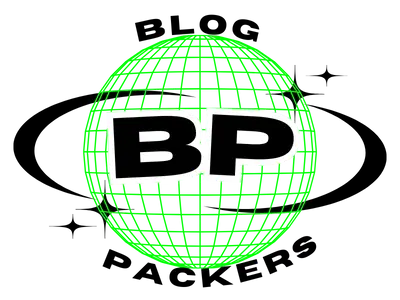
Pingback: Top 21 Examples of Upcycled Packaging
Pingback: Jute Packaging from Golden Fibers